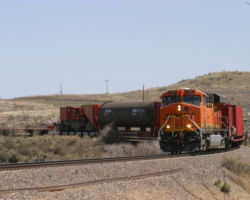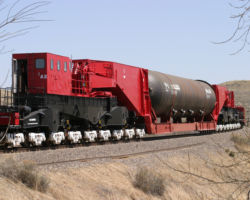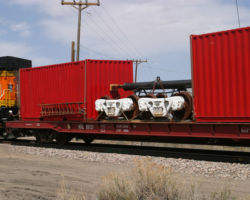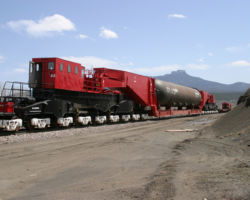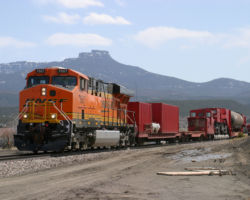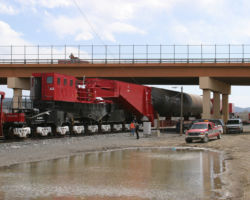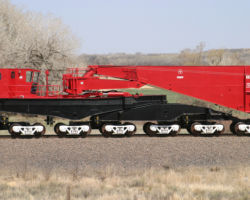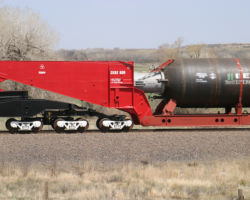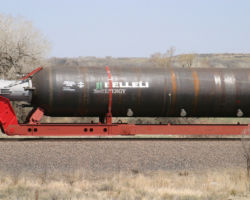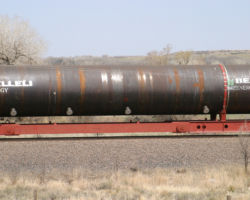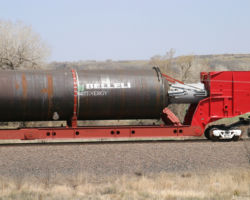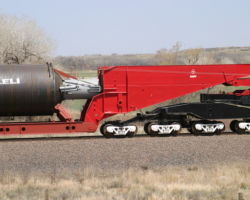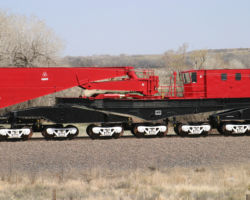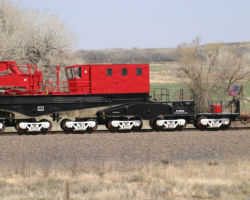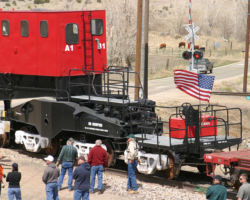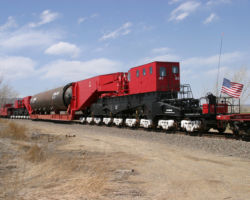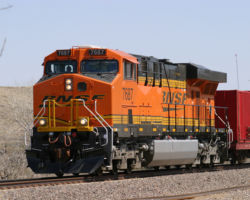There’s only one railcar like it in the world, and it’s the biggest of its breed. Having 36 axles and being 232 feet long and 370 tons with no load in the middle, and capable of being up to 345 feet long and 1250 tons with a load, there’s no denying it’s huge. The CEBX 800 Schnabel was built in 1980 by Krupp Industrie und Stahlbau (now part of Thyssen Krupp) for Combustion Engineering, hence the CEBX reporting marks. Its original purpose was to haul large heavy bits of nuclear power facilities for Combustion Engineering. More recently, the car has found work in the petroleum business, hauling a good number of huge refinery components around Canada, and for the last few weeks, hauling a 590-ton hydrotreater from the Port of Houston to the Suncor Refinery in Commerce City, CO (near Denver).
So, the question on everybody’s mind… What’s a hydrotreater, other than obviously huge and heavy? Best I understand it, it’s a reactor that hydrogenates fuel oil products to reduce the impurities. Exposing the petroleum soup to hydrogen under the proper conditions (and presumably with some sort of catalysts), sulfur in the mix becomes hydrogen sulfid and nitrogen converts to ammonia. My assumption is that the removal of sulfur is the drive behind this one, as several press releases have made statements to the effect that it’ll be used to increase production of low-sulfur diesel fuel.
The hydrotreating unit, brought to Houston (presumably from Belleli Energy in Italy) by ship, was offloaded onto the railcar on 22-Mar-2005, and left Houston a few days later, on 28-Mar-2005, via a very special BNSF move. The train, called J-PTRDEN1-28, consisted of a brand new GE ES44DC unit, BNSF 7687, bearing the new BNSF logo, KRL 89121 (a flat with spare parts), KRL 70951 (an idler flatcar), KRL 076 (a caboose), the big boy itself – CEBX 800, KRL 70897 (another idler flat), and KRL 074 bringing up the rear (another caboose). The movement is followed by a gaggle of BNSF employees, including hyrails leading and following the move, a BNSF Police presence, various crews to move obstructions, and of course just a few employees that want to see the movement happen. Limited to a maximum of 15 miles per hour and moving only during daylight, the movement has taken several weeks now to even get to Colorado. Finally, on the morning of 9-Apr-2005, it entered the state via BNSF’s Twin Peaks Subdivision, the former Fort Worth & Denver line coming into Trinidad from the southeast.
On a hunch and a few tips, I headed out Saturday morning. The most confusing part was that press releases had it moving through La Junta, but various sightings had it coming up via the Twin Peaks line through Clayton, Texline, etc. So, I figured sightings are better than press releases, and headed for Trinidad. As I approached the Beshoar siding (just southeast of town), I saw the pilot hyrail truck come into view. A few minutes later, the movement itself showed up and eased itself under US 160/350, followed by another hyrail. I caught it several more times on the way into town – it was probably averaging less than 10 mph for those few miles.
Just north of Trinidad, I waited at the CO-239 crossings along with a couple dozen other folks hoping to see it, most not railfans. It came around the curve and over the ex-ATSF Raton Subdivision, and then did something most unexpected – stopped just past the switch to the track connecting the Twin Peaks and Raton subdivisions. A quick check with a BNSF guy nearby revealed that due to clearances near Pueblo, they’d actually be backing onto the Raton Sub and heading out to La Junta, then back to Pueblo. That explained the press releases about a La Junta routing… After nearly two hours of pulling switch stands and crossing signs and gingerly backing up the huge load, they finally made it down onto the Raton Sub only to get held again.
Coming from the west was an eastbound Z train, and the dispatcher was holding J-PTRDEN1-28 until its arrival. It’s probably not good to stick the only fast intermodal train on the line behind a slow, plodding high-wide move. Fifteen minutes or so later, the Z appeared, and in true Raton Sub style, was gone in the blink of an eye. Knowing the special wouldn’t get going that fast, I followed the Z out to Model, CO (about 20 miles out), grabbed a couple shots, and headed back. The day ended with a few more shots of the special around Hoehne, CO, just east of Trinidad and only a few miles from where the day had begun for me.
The movement should be in Denver by next weekend, targeted with an arrival date at Commerce City, CO, of 15-Apr-2005.
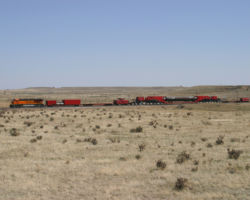
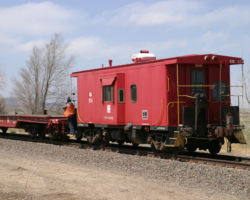
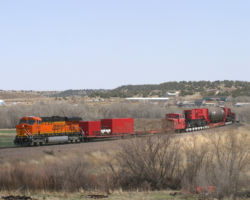
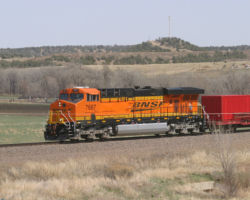
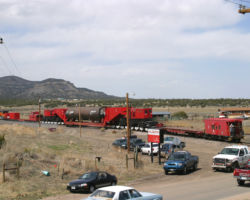
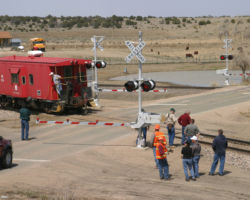
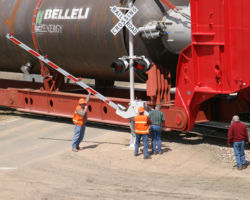
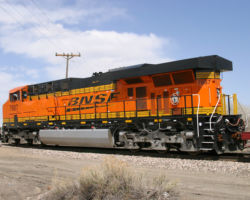
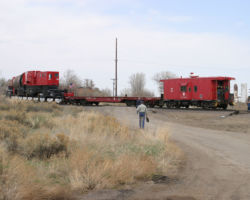
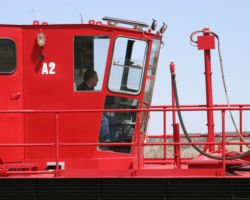
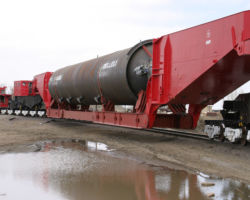
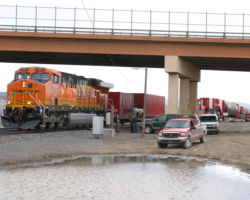
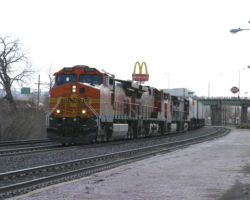
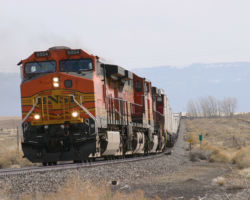
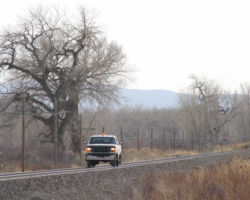
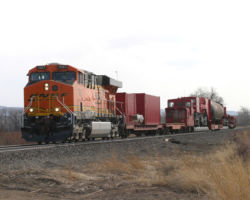
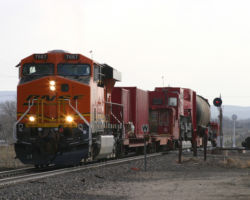
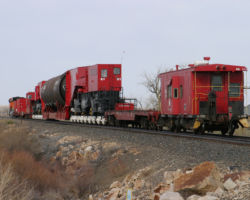
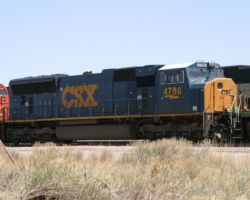
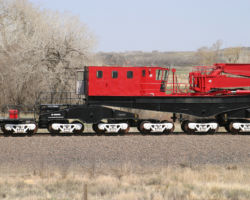
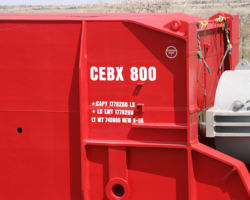
All photographs in this trip report were taken with a Canon EOS 10D using either a Canon 28-105mm USM or a Canon 75-300mm f4-5.3 IS/USM.
This work is copyright 2024 by Nathan D. Holmes, but all text and images are licensed and reusable under a Creative Commons Attribution-NonCommercial-ShareAlike license. Basically you’re welcome to use any of this as long as it’s not for commercial purposes, you credit me as the source, and you share any derivative works under the same license. I’d encourage others to consider similar licenses for their works.
